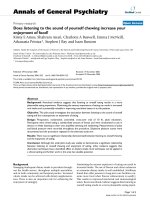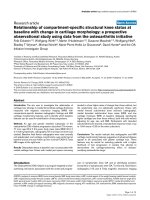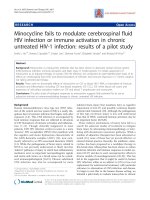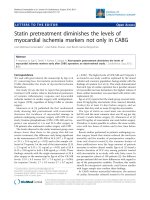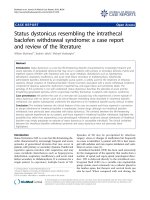Báo cáo y học: "Trauma admissions to the Intensive Care Unit at a reference Hospital in Northwestern Tanzania" ppsx
Bạn đang xem bản rút gọn của tài liệu. Xem và tải ngay bản đầy đủ của tài liệu tại đây (191.39 KB, 18 trang )
This Provisional PDF corresponds to the article as it appeared upon acceptance. Fully formatted
PDF and full text (HTML) versions will be made available soon.
Trauma admissions to the Intensive Care Unit at a reference Hospital in
Northwestern Tanzania
Scandinavian Journal of Trauma, Resuscitation and Emergency Medicine 2011,
19:61 doi:10.1186/1757-7241-19-61
Phillipo L Chalya ()
Japhet M Gilyoma ()
Ramesh M Dass ()
Mabula D Mchembe ()
Michael Matasha ()
Joseph B Mabula ()
Nkinda Mbelenge ()
Willliam Mahalu ()
ISSN 1757-7241
Article type Original research
Submission date 3 February 2011
Acceptance date 24 October 2011
Publication date 24 October 2011
Article URL />This peer-reviewed article was published immediately upon acceptance. It can be downloaded,
printed and distributed freely for any purposes (see copyright notice below).
Articles in SJTREM are listed in PubMed and archived at PubMed Central.
For information about publishing your research in SJTREM or any BioMed Central journal, go to
/>For information about other BioMed Central publications go to
/>Scandinavian Journal of
Trauma, Resuscitation and
Emergency Medicine
© 2011 Chalya et al. ; licensee BioMed Central Ltd.
This is an open access article distributed under the terms of the Creative Commons Attribution License ( />which permits unrestricted use, distribution, and reproduction in any medium, provided the original work is properly cited.
1
Trauma admissions to the Intensive Care Unit at a reference Hospital in Northwestern
Tanzania
Phillipo L. Chalya
1
*, Japhet M. Gilyoma
1
§
, Ramesh M. Dass
2
§
, Mabula D. Mchembe
3
§
, Michael Matasha
4
§
,
Joseph B. Mabula
1
§
, Nkinda Mbelenge
2
§
, William Mahalu
5
§
1
Department of Surgery, Weill-Bugando University College of Health Sciences, Mwanza, Tanzania
2
Department of Orthopaedics, Weill-Bugando University College of Health Sciences, Mwanza, Tanzania
3
Department of Surgery, Muhimbili University of Health and Allied Sciences, Dar Es Salaam, Tanzania
4
Department of Anaesthesia, Weill-Bugando University College of Health Sciences, Mwanza, Tanzania
5
Cardiothoracic unit, Weill-Bugando University College of Health Sciences, Mwanza, Tanzania
Email address
PLC:
JMG:
RMD:
MDM:
MM:
JBM:
NM:
WM:
*Corresponding author § Equal contributors
Abstract
Background: Major trauma has been reported to be a major cause of hospitalization and intensive care
utilization worldwide and consumes a significant amount of the health care budget. The aim of this study was
2
to describe the characteristics and treatment outcome of major trauma patients admitted into our ICU and to
identify predictors of outcome.
Methods: Between January 2008 and December 2010, a descriptive prospective study of all trauma
admissions to a multidisciplinary intensive care unit (ICU) of Bugando Medical Centre in Northwestern
Tanzania was conducted.
Results: A total of 312 cases of major trauma were admitted in the ICU, representing 37.1% of the total ICU
admissions. Males outnumbered females by a ratio of 5.5:1. Their median age was 27 years. Trauma
admissions were almost exclusively emergencies (95.2%) and came mainly from the Accident and Emergency
(60.6%) and Operating room (23.4%). Road traffic crash (RTC) was the most common cause of injuries
affecting 70.8% of patients. Two hundred fourteen patients (68.6%) required surgical intervention. The
overall ICU length of stay (LOS) for all trauma patients ranged from 1 to 59 days (median = 8days). The
median ICU length of hospital stay (LOS) for survivors and non-survivors were 8 and 5 days respectively. (P
= 0.002). Mortality rate was 32.7%. Mortality rate of trauma patients was significantly higher than that of all
ICU admissions (32.7% vs. 18.8%, P = 0.0012). According to multivariate logistic regression analysis,
multiple injuries, severe head injuries and burns were responsible for a longer mean ICU stay (P<0.001)
whereas admission Glasgow Coma Score < 9, systolic blood pressure < 90mmHg, injury severity core >16,
prolonged duration of loss of consciousness, delayed ICU admission (0.028), the need for ventilatory support
and finding of space occupying lesion on computed tomography scan significantly influenced mortality
(P<0.001).
Conclusion: Trauma resulting from road traffic crashes is a leading cause of intensive care utilization in our
hospital. Urgent preventive measures targeting at reducing the occurrence of RTCs is necessary to reduce ICU
trauma admissions in this region. Improved pre- and in-hospital care of trauma victims will improve the
outcome of trauma patients admitted to our ICU.
3
Key words: Intensive care unit; trauma admissions; prevalence; injury characteristics; outcome; Tanzania
Background
Major or severe trauma constitutes a global public health problem and poses diagnostic and therapeutic
challenges to trauma, orthopaedic and general surgeons practicing in developing countries [1]. Major trauma
contributes significantly to high morbidity, mortality and long-term disabilities worldwide [1, 2]. In
developing countries including Tanzania, injuries in general are increasing due to increase in urbanization,
motorization, civil violence, wars and criminal activities [3]. In these countries, major trauma remains a major
cause of hospitalization and intensive care utilization and consumes a significant amount of the health care
budget [4]. In Bugando Medical Centre, major trauma is the single most common reason for admission to the
Intensive Care Unit (ICU) and is it associated with substantial emotional, physical and financial burden on
community and hospital resources.
Major trauma is often life threatening and usually presents as an emergency, requiring either immediate
surgical intervention or intensive care or both [4, 5]. The Intensive Care Unit is a specialized area where
facilities for the critically ill or severely injured patients are concentrated and where the level of care and
supervision is considerably more sophisticated than in the ordinary ward [4-6]. Worldwide, intensive care unit
requires a vast use of up to date resources such as advanced monitors, organ support equipments and highly
skilled staff. This however, often taxes the most buoyant health systems even of the developed nations [4, 6].
In most developing nations where there are several financial constraints resulting from poor funding of the
health care generally and the ICU specifically, there is often a limit to the availability and specialization of
this form of care [6].Besides allocation of resources, intensive care also demands a tremendous amount of
time and effort on behalf of the medical and nursing staff to treat and improve survival of the critically ill
patients. It therefore follows that the role of the ICU must be justified wherever it exists [5, 6]. The allocation
4
of ICU facilities when financial resources are limited is determined by cost/benefit and patient outcome [6, 7].
Admission of patients with poor prognosis and/or prolonged use of the ICU facility results in other patients
with a better prognosis being denied care; many of these die as a result [7].
Despite continued advances in intensive care unit technology and the availability of sophisticated
interventions for the treatment of critically ill or severely injured patients, major trauma patients continue to
die in the ICU [6, 7]. Identification of factors responsible for this state of affairs is of paramount in order to
improve the outcome these patients. Understanding the magnitude of the problem and characterizing the
patterns of injury in these patients is important in planning programmes targeted at preventing their
occurrence and subsequently reduce ICU admissions. There is paucity of published data on ICU trauma
admissions in our environment despite large number of trauma admissions to our ICU. This study was
conducted to describe the characteristics and treatment outcome of major trauma patients admitted into our
ICU and to identify predictors of outcome.
Methods
Study design and setting
Between January 2008 and December 2010, a descriptive prospective study was conducted in the ICU of
Bugando Medical Centre (BMC). BMC is found in Mwanza city in the Northwestern Tanzania along the
shore of Lake Victoria. It is one of the four tertiary referral hospitals in the country and serves as a teaching
hospital for Weill- Bugando University College of Health Sciences (WBUCHS) and other paramedics. It has a
bed capacity of 1000 and provides services to approximately 13 million people from six regions namely
Mwanza, Kagera, Mara, Shinyanga, Kigoma and Tabora. The hospital has a 12-bed adult and 10-bed
paediatric multi-disciplinary Intensive Care Unit (ICU) which is headed by a consultant anesthesiologist and
run by trained ICU nurses. The ICU provides services to all patients (trauma and non-trauma, medical and
5
surgical) requiring advanced airway support, mechanical ventilation, hemodynamic support, and electronic
monitoring which are usually not available in the open wards in our hospital. The majority of trauma patients
admitted in the ICU come from the Accident and Emergency (A & E) department, operating theatre, wards
and others come from other peripheral hospitals.
Study subjects
The study subjects included all patients with traumatic injuries severe enough to warrant ICU admission and
who consented for the study. Patients who were readmitted to the ICU during the same hospital stay were
excluded from the study. A total of 334 patients were recruited for the study and screened for inclusion
criteria. Of these, 314 patients met the inclusion criteria and the remaining 20 patients did not. Patients who
met the inclusion criteria were requested to consent for the study before being enrolled in the study. Two
patients refused to consent for the study. Thus, 312 patients were enrolled in the study. .
All study patients were initially resuscitated according to ATLS and treated according to ICU protocols. The
severity of injury was assessed by the injury severity score (ISS) and the Glasgow coma score (GCS). An
initial systolic blood pressure (SBP) on each patient was also recorded on admission. Data were collected used
a questionnaire. Data administered in the questionnaire included details of demographic profile, causes of
injury, injury characteristics, injury severity using Glasgow Coma scale (GCS) and injury severity score (ISS),
treatment offered, complications, ICU length of stay (LOS), mortality and patient disposal. ICU length of
stay. Patients were followed up till death or discharge from the ICU.
Statistical data analysis
Data collected was analyzed using SPSS software version 15.0. Data was summarized in form of proportions
and frequent tables for categorical variables. Continuous variables were summarized using means, median,
mode and standard deviation. χ2-test was used to test for significance of associations between the predictor
and outcome variables in the categorical variables. Student t-test was used to test for significance of
6
associations between the predictor and outcome variables in the continuous variables Significance was
defined as a p-value of < 0.05. Multivariate logistic regression analysis was used to determine predictor
variables that are associated with outcome.
Variable definitions
Road traffic crash was defined as accident which took place on the road between two or more objects one of
which must be any kind of a moving vehicle.
Patients were divided into two groups according to the timing of ICU admission on arrival. Patients who were
admitted to the ICU immediately on arrival were classified as “immediate admission group” and patients who
had to wait for ICU admission due to bed unavailability or any other reason were classified as “delayed
admission group”. The nature of injury was classified as “intentional injuries” defined as injuries that occur as
a result of interpersonal or self-inflicted violence and “unintentional injuries” defined as injuries that occur
accidentally. ICU length of stay was arbitrary dichotomized into two groups’ i. e. ≤ 14 days and > 14 days
respectively. An ICU length of stay of > 14 days was considered as prolonged hospital stay.
Ethical consideration
Ethical approval to conduct the study was obtained from the WBUCHS/BMC joint institutional ethic review
committee before the commencement of the study. Patients who met the inclusion criteria or their relative
were requested to sign a written informed consent before being enrolled into the study.
Results
There were a total of 312 trauma admissions to the ICU during the period under study, representing 37.1%
(312/ 841) of the total ICU admissions. There were 264 (84.6%) males and females were 48 (15.4%) with a
males to female ratio of 5.5:1 compared with 1.2:1 for the total ICU admissions. Their ages ranged from 4
years to 71 years (median 27 years). Trauma admissions were almost exclusively emergencies (95.2%) and
7
came mainly from the Accident and Emergency (60.6%) and Operating Room / Post Anaesthesia Care Unit
(23.4%). (Table 1)
The majority of the injuries were unintentional in 232 (74.4%) patients. Intentional injuries were recorded in
sixty (19.2%) of cases and the remaining twenty (6.4%) patients were cases of indeterminate intent. Road
traffic crush was the most common cause of injuries affecting 70.8% of patients (Table 2).
One hundred and fifty-two (68.8%) of RTCs were related to motorcycle injuries affecting motorcyclists (93,
61.2%), passengers (40, 26.3%) and pedestrian (19, 12.5%).
The head /neck and musculoskeletal (extremities) regions were commonly affected accounting for 95.5% and
34.6% of cases respectively (Table 3). Isolated injuries occurred in 208 (66.7%) patients while 104 (33.3%)
patients had multiple injuries. Soft tissue injuries (i.e. bruises, laceration, abrasion and contusions) and
fractures (long bones, spines, pelvis, ribs, and skull) were the most common type of injuries accounting for
97.8% and 32.4% respectively (Table 4).
The ISS ranged from 16-56 with the mean of 19.74 ± 9.81. The median was 17.00. The mean GCS for
patients with head injuries was 9.65± 12.43 (range 3-15). The median GCS was 9. The majority of patients
(172, 55.1%) had admission SBP < 90 mmHg.
Of the 312 patients admitted to the ICU, 169 (54.2%) patients were intubated and ventilated for a median of 7
days (range 1-32 days).Two hundred fourteen patients (68.6%) required surgical intervention. Wound
debridement, treatment of fractures and craniotomies were the commonest surgical procedures performed in
95.3%, 43.5% and 14.5% of patients respectively (Table 5).
The overall ICU length of stay (LOS) for all trauma patients ranged from 1 to 59 days (median = 8days). The
median ICU length of hospital stay (LOS) for survivors and non-survivors were 8 and 5 days respectively.
These differences were statistically significant (P = 0.002).
8
Of the non-survivors, ten (9.8%) died within 24 hours of ICU admission while twenty-four (23.5%) died
within 72 hours and six-eighty (66.7%) died by the seventh ICU day. Of the survivors, thirty-two (15.2 %)
were discharged to the wards within 72 hours, fifty-four (25.7%) on the seventh day and one hundred and
twenty-four (59.0%) were discharged by the fourteenth day of ICU admission.
Analysis of outcome showed that 201(64.4%) patients were transferred to the ward and 4 (1.3%) patients were
discharged home direct from the ICU. 3 patients (1.0%) were referred to another tertiary institution and 1
(0.3%) patient each absconded and left against medical advice respectively. A total of 102 patients died giving
a mortality rate of 32.7%. Mortality rate of trauma patients was significantly higher than that of all ICU
admissions (32.7% vs. 18.8%, P = 0.0012). According to multivariate logistic regression analysis, multiple
injuries (O.R.= 2.34, 95% C.I.( 2.11-4.78), P= 0.012), severe head injuries [GCS = 3-8] (O.R.= 0.54, 95%
C.I.(0.13-0.69), P= 0.036) and burns (O.R.=4.92, 95%C.I. (2.43-8.15), P= 0.017) were responsible for a
longer (> 14 days) ICU stay. Table 6 shows predictors of mortality according to univariate and multivariate
analysis
Discussion
Number of ICU trauma admission
In this review, major trauma was the most common indication for admissions into our ICU (37.1%), and
represented 95.2% of emergency ICU admissions. This is higher than that reported in Jamaica and Nigeria by
Mitchell et al [7] and Amanor-Boadu et al [8] respectively. ICU admission has been reported to be the most
important factor in determining the ultimate outcome of critically ill and major trauma patients and to be
successful requires adequate logistic and financial support, supporting disciplines (e.g. laboratories, radiology
and surgery) and basic infrastructure such as good roads, regular electricity, water supply, availability of
drugs by the patient's bedside and regular oxygen and compressed air supply [9]. Many of these are not
regularly available in many low resource settings. It has been suggested that the inadequate medical and
9
technical equipment of most ICUs in low resource economies substantially contribute to the high mortality
rate of critically ill patients in such countries [10]. Facilities in our ICU are limited and obviously insufficient
to cope with the number of patients being admitted.
Demographic profile
In agreement with previous studies [5-8, 11], trauma patients admitted to our ICU were mostly young males,
and had a better previous health status than most other ICU patients. However, the mortality was higher
among them compared to the non-trauma patients. This group represents the economically active age and
portrays an economic lost both to the family and the nation and the reason for their high incidence of
traumatic injuries reflects their high activity levels and participation in high-risk activities. Male
predominance in the present study is due to their increased participation in high-risk activities. The fact that
the economically productive age-group were mostly involved calls for an urgent public policy response.
Timing of ICU admission
In keeping with other studies [12, 13], our study has demonstrated an association between delay to ICU
admission and higher mortality rate reflecting worsening of organ dysfunction during this period. Despite the
care provided by ward healthcare workers while patients were waiting for ICU bed availability, these
healthcare providers were not trained in critical care and were not as experienced in caring for ICU patients.
Furthermore, hospital wards are neither designed nor staffed to provide extended longitudinal care for the
critically ill patient. These patients have better outcomes when treated in ICUs with close and continuous
involvement by critical care physicians [14, 15] and other data also show improved outcome when nurse-to-
patient ratios in the ICUs are properly maintained [16]. Caring for critically ill patients outside the ICU may
also imply an increased burden and high stress level experienced by hospital wards staff.
Etiological pattern
10
Road traffic crushes have been reported to be the commonest cause of ICU trauma admissions in most studies
as supported by the present study [7, 8, 11]. This may be attributed to recklessness and negligence of the
driver, poor maintenance of vehicles, driving under the influence of alcohol or drugs and complete disregard
of traffic laws. In the present study, motorcycle injuries accounted for more than fifty percent of road traffic
injuries and the motorcyclist constituted the majority of motorcycle injury victims. Findings from this study
calls for urgent interventions targeting at reducing the occurrence of RTCs and subsequently reduce the
incidence of ICU admissions in this region.
Type of injuries
The majority of our patients sustained head and musculoskeletal injuries, which is in keeping with previous
studies [6-8, 17-19]. Severe road traffic crashes are usually associated with significant head, musculoskeletal
and multiple injuries, which explain why they are the leading cause of our ICU admissions, unlike in the
wards.
Trauma scores
The severity of injury on admission in the present study was assessed by the ISS and the GCS. Most validated
ICU scoring system such as admission APACHE (Acute physiology age and chronic health evaluation) II
Score were not used in this study because the majority of patients were transferred to the unit after initial
stabilization from the Accident and Emergency unit. Also APACHE II score use parameters that require
arterial blood gas analysis and other variables that we were unable to measure.
Length of ICU stay
In this study, survivors had a statistically significant longer LOS than non-survivors which is in agreement
with other studies in developing countries [7, 8, 20], but contrary to studies in developed countries which
reported non-survivors staying longer and consuming more resources than survivors [10, 21]. This difference
11
in survival is probably due to a combination of factors including severity of injuries, poor pre-hospital care,
lack of emergency medical services, and lack of appropriate diagnostic and therapeutic facilities including
drugs for the care of these patients in the hospital and the ICU. These factors have been adequately addressed
in developed nations.
Mortality
Our mortality rate (32.7%) in the present study was higher than the mortality rate of 26.4% reported by
Mitchel et al [7] in Jamaica but lower compared to mortality rate of 53.2% reported by Adenekan et al [20] in
Nigeria. Higher mortality rate in our study may be attributed to severity of injuries, lack of advanced pre-
hospital care in our setting, ineffective ambulance system for transportation of patients to hospitals, and lack
of appropriate diagnostic and therapeutic facilities including drugs for the care of these patients in the hospital
and the ICU. This observation calls for improved pre- and in-hospital care of trauma victims so as to improve
the outcome of trauma patients admitted to our ICU.
Study limitations
Despite limitations of the study such as limited ICU space, unavailability of diagnostic tools (e.g. Computed
tomography scan) and short-term study limited to ICU stay, this study demonstrated the impact of trauma
admissions to our ICU.
Conclusion
Major trauma resulting from road traffic crashes is a leading cause of intensive care utilization in our hospital.
Urgent preventive measures targeting at reducing the occurrence of RTCs is necessary to reduce the incidence
of major trauma in this region and subsequently reduce ICU trauma admissions. These preventive measures
include increased public education, enforcement of road safety rules, improvement in socioeconomic situation
and employment opportunities in our country. Improved pre- and in-hospital care of trauma victims will
improve the outcome of major trauma patients admitted to our ICU.
12
Competing interests
The authors declare they have no competing interest.
Authors' contributions
PLC contributed in study design, literature search, data analysis, manuscript writing & editing. JMG and
RMD participated in study design, data analysis, manuscript writing & editing. MDM participated in data
analysis, manuscript writing & editing. MM and JBM participated in data analysis and manuscript writing.
WM supervised the study and contributed in data analysis, manuscript writing & editing. All the authors read
and approved the final manuscript.
Acknowledgement
The authors acknowledge all those who provided care to our patients and those who provided support in
preparation of this manuscript. Special thanks go to our research assistants for data collection and staff
members of the ICU for their critical support in patient care.
References
1. Hofman K, Primack A, Keusch G, Hrynkow S: Addressing the growing burden of trauma and injury
in low- and middle-income countries. Am J Public Health 2005, 95:13-7
2. Park K: Accidents. In Textbook of Social and Preventive Medicine. 17 edition.Edited by: Park K.
Jabalpur: Banarsidas Co; 2000, 304-5.
3. Museru LM, Leshabari MT: Road traffic Accidents in Tanzania: A 10-year epidemiological
Appraisal. East Central Afr. J. Surg. 2002, 7: 23-26
4. Moini M, Rezaishiraz, H, Zafarghandi MR: Characteristics and outcome of injured patients treated in
urban trauma centers in Iran. J Trauma 2000, 48:503–7
5. Duane T.M., Rao R.I., Aboutanous M.B., Wolfe L.G., Malhotra A.K: Are trauma patients better off in
a trauma ICU? J Emerg Trauma, Shock 2008, 1:74-7
13
6. Abubakar A. S., Ojo E. O., El-Nafaty A. U., Edomwonyi N. P: An audit of one-year intensive care
practice in a developing country. The Internet Journal of Anesthesiology. 2008,18:2
7. Mitchell V. T., Scarlett M. D., Amata A. V: Trauma Admissions to the ICU of the University Hospital
of the West Indies, Kingston, Jamaica. Trauma Care Fall/ Winter 2001: 86 –89.
8. Amanor-Boadu S. D., Sanusi A. A., Oyeleke S. O. Soyannwo O. A: Intensive Care for Trauma Victims
in a Developing Country: Priorities and Challenges for Improvement. Afr J Trauma 2003, 1: 51–53.
9. Bastos P. C., Knaus W. A., Zimmermann J. I: The importance of technology for achieving superior
outcome from intensive care. Brazil APACHE lll study group Intensive Care Med 1996, 22, 664–669.
10. Nakamura T., Nishimura M., Okada Y: Evaluation of mortality of patients admitted to ICU for the
last 12 years. Masui 1999, 48, 1332–6
11. Chalya P.L., Mabula J.B., Ngayomela I.H., Kanumba E.S., Chandika A.B., Giiti G., Mawala B.,
Balumuka, D.D: Motorcycle injuries as an emerging public health problem in Mwanza City, north-
western Tanzania. Tanzania Journal of Health Research 2010, 12:214-221.
12. Chalfin DB, Trzeciak S, Likourezos A, Baumann BM, Dellinger RP; Delayed study group: Impact of
delayed transfer of critically ill patients from the emergency department to the intensive care unit.
Crit Care Med 2007, 35:1477-1483.
13. Young MP, Gooder VJ, McBride K, James B, Fisher ES: Inpatient transfers to the intensive care unit:
Delays are associated with increased mortality and morbidity. J Gen Intern Med 2003, 18:77-83
14. Pronovost PJ, Angus DC, Dorman T, Robinson KA, Dremsizov TT, Young TL: Physician staffing
patterns and clinical outcomes in critically ill patients: a systematic review. JAMA 2002, 288:2151-
2162.
14
15. Multz AS, Chalfin DB, Samson IM, Dantzker DR, Fein AM, Steinberg HN, Niederman MS, Scharf SM:
A “closed” medical intensive care unit (MICU) improves resource utilization when compared with
an “open” MICU. Am J Respir Crit Care Med 1998, 157:1468–1473.
16. Thorens JB, Kaelin RM, Jolliet P, Chevrolet JC: Influence of the quality of nursing on the duration of
weaning from mechanical ventilation in patients with chronic obstructive pulmonary disease. Crit
Care Med 1995, 23:1807–1815
17. Size M., Borgstein E.S., Haisma H.J: One year audit of admission to the Intensive Care Unit of the
Queen Elizabeth Central Hospital, Blantyre. Malawi Med J 2005, 17, 1, 12-14
18. Harding-Goldson H.E., , Crandon IW., McDonald A.H., Augier R., Fearon-Boothe D., Rhoden A.,
Meeks-Aitken N: Surgical and Intensive Care needs of Head-injured Patients Transferred to the
University Hospital of the West Indies. West Indian Med J 2007; 56 (3): 230-234
19. Oyegunle A. O., Oyegunle V. A: The Intensive Care Unit in a Young Nigeria Teaching Hospital: The
Sagamu (1994-1997) Experience – A retrospective study. Afr J Anaesth Int Care 1997, 3, 41–43.
20. Adenekan A.T., Faponle A.F: Trauma Admissions to the ICU of a Tertiary Hospital in a Low
Resource Setting. African Journal of Anaesthesia and Intensive Care 2009, 9,(2), 5-7
21. Byrick R. J., Caskennette G. M. Audit of critical care: aims, uses, costs and limitations of a Canadian
system. Can J Anaesth 1992, 39, 260–9.
15
Table 1: Demographic and clinical characteristics of the ICU trauma admissions
Study variable Trauma admission Total admission
Number (N/%)
312 (37.1) 841 (100)
Sex (Male: Female ratio)
5.5: 1 1.2:1
Median age (in years)
27 30
Modal age group (years)
21-30 31-40
Source of admission (N/%)
° A & E department
° OR/PACU
° Wards
° Other hospital s
° Unspecified
Timing of admission
° Immediately
° Delayed
189 (60.6)
73 (23.4)
33 (10.3)
17 (5.7)
-
111 (35.6)
201 (64.4)
301 (35.8)
385 (45.8)
132 (15.7)
22 (2.6)
1 (0.1)
365 (43.4)
476 (56.6)
Type of admission (N/%)
° Emergency
° Elective
297 (95.2)
15 (4.8)
573 (68.1)
268 (31.9)
Length of hospital stay (N/%)
° < 3 days
° ≥ 3 days
110 (35.1)
202 (64.9)
370 (44.0)
471 (56.0)
Mortality rate (%)
102 (32.7) 158 (18.8)
Keys: A & E = Accident and Emergency; OR= Operating Room; PACU= Post Anaesthesia Care Unit
Table 2: Causes of injuries among ICU trauma victims
Cause of injury Number of patients Percentage
Road traffic crush 221 70.8
Assaults 36 11.5
Falls 12 3.8
Burns 9 2.9
Other causes 14 4.5
Unknown 20 6.4
Total 312 100
16
Table 3: Site of injury among ICU trauma victims
Site of injury Frequency Percentage
Head / neck 298 95.5
Musculoskeletal (extremities) 108 34.6
Chest 82 26.3
Abdomen 62 19.9
Pelvis 14 4.5
Spines 8 2.6
Genitalia 4 1.3
Table 4: Type of injuries among ICU trauma victims
Type of injury Frequency Percentage
Soft tissue injuries (wounds) 305 97.8
Fractures 101 32.4
Craniocerebral injury 67 21.5
Visceral injury
Burns
41
9
13.1
2.9
Other injuries 12 3.8
Table 5: Type of surgical procedure performed (N=214)
Surgical procedure Frequency Percentages
Wound debridement 204 95.3
Treatment of fractures 93 43.5
Craniotomy (including
elevation of skull fracture)
31 14.5
Underwater seal drainage 23 10.7
Exploratory laparotomy 17 7.9
Tracheostomy 12 5.6
Eye surgery 9 4.2
Thoracotomy 2 0.9
Table 6: Predictors of mortality according to univariate and multivariate analysis
Univariate analysis Multivariate analysis Independent
(predictor)variable
Number of
patients (N/%)
OR. (95%C.I) p-value OR. (95%C.I) p-value
Age
≤40
202(64.7) 1 1
> 40 110(35.3) 1.41 (0.45-1.82) 0.098 2.5 (0.56-6.67) 0.765
Sex
Male 264(84.6) 1 1
Female 48 (15.4) 4.52 (0.95-5.83) 0.678 3.12(0.97-5.78)
Type of admission
Emergency 297(95.2) 1 1
17
Elective 15 (4.8) 2.71 (1.2-3.7) 0.024 3.83 (0.93-5.98) 0.934
Timing of admission
Immediately 111 (35.6) 1 1
Delayed 201 (64.4) 2.93 (2.22-8.45) 0.003 3.43(2.26-7.91)
0.028
Duration of LOC (N=214)
≤ 2 hours
72(33.6) 1 1
> hours 146(68.2) 2.23 (1.89-7.98) 0.000 0.34(0.12-0.78)
0.004
ISS
≤ 15
2(0.6) 1 1
>15 310 (99.4) 6.83(3.56-8.91) 0.012 7.21 (2.65-10.96)
0.000
GCS
<9 192(61.5) 1
≥9 120(38.5) 2.64( 1.32-6.76) 0.034 4.72 (3.16-9.23)
0.003
Admission SBP(mmHg)
< 90 172(55.1) 1 1
≥90
140(44.9) 1.76(0.56-4.35) 0.042 8.34 (4.61-9.98)
0.016
Need for ventilatory
support
Yes 169(54.2) 1 1
No 143 (45.8) 2.45(1.24-5.89) 0.038 0.65 (0.28-0.86)
0.018
CT scan brain findings of
SOL (N=122)
Yes 98(80.3) 1 1
No 24(19.7) 0.77 (0.23-0.98) 0.000 3.53(2.23-6.97)
0.015
Abbreviations: O.R.= Odds ratio; C.I.= confidence interval; LOC= loss of consciousness; ISS= injury severity score; GCS=
Glasgow coma scale; SBP= systolic blood pressure; SOL= space occupying space
